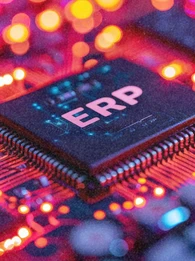
Here are seven storage trends that Infinidat has identified heading into 2024.
#1: Triple play of cyber resiliency, detection, and recovery to create an overall corporate cybersecurity strategy
The convergence of cyber resilience, detection, and recovery on a single storage platform is fuelling a trend for 2024 around higher levels of cybersecurity for enterprise storage. Reliance solely on backup is no longer enough to secure storage systems. Primary storage has become a main target of cybercriminals for the most insidious and hard-to-detect ransomware and malware attacks that wreak costly havoc on enterprises. Combining resilience (the ability to instil defensive security measures to repel attacks), detection (the ability to know when data is corrupted and whether a known good copy of data is free of ransomware or malware), and recovery (the ability to bounce back) from cyberattacks is the key to hardening storage infrastructure.
This trend to better secure storage systems is highly important because of the continued exponential increase in cyberattacks against enterprises of all types and in all industries. Cybercrime is predicted to grow from $8 trillion worldwide in 2023 to more than $10 trillion in 2025. Cybercriminals attempted nearly 500 million ransomware attacks last year, marking the second-highest year ever recorded for ransomware attacks globally, and in the 2023 Fortune CEO survey of “Threats” to their companies, CEOs named cybersecurity their #2 concern. Ransomware attacks also represented 12% of breaches of critical infrastructure in the last year.
The convergence of cyber resilience, detection, and recovery on an integrated storage platform is an advancement over the past, commonly-used approach of disparate tools and technologies trying to combat cyberattacks in silos. Improving the security defences of cyber storage for enterprises eliminates the vulnerabilities of the silos. It makes the cyber capabilities more air-tight and ensures a rapid recovery of data within minutes to thwart cybercriminals, nullifying ransom demands and preventing (or minimising) any downtime or damage to the business. Ignoring this trend in 2024 could greatly harm an enterprise, especially one that doesn’t even know cybercriminals are lurking in their data infrastructure, no matter how good their other cybersecurity defences are.
#2: Freeing up money from storage for AI and other critical IT projects
Dramatically reducing the costs of enterprise storage frees up IT budget to fund other significant new projects, such as AI projects, cybersecurity-related projects, or other strategic activities. This trend for 2024 will play a pivotal role in enterprises where there will be pressure to accelerate AI projects for the next stage of digital transformation, as well as to improve cybersecurity against more sophisticated AI-driven cyberattacks. With IT budgets projected by Gartner to grow by 8% in 2024, funding for these new projects will need to come from somewhere.
A smart approach to shifting IT spending internally that is taking hold is to remove costs from storage, while simultaneously improving storage. It sounds like a paradox at first sight, but the trend in 2024 will be to take advantage of three key factors that make this “paradox” an actual reality: (1) storage consolidation onto a single, scalable high availability and high performance platform, (2) autonomous automation, and (3) pay-as-you-go, flexible consumption models for hybrid cloud (private cloud and public cloud) implementations of storage.
Storage consolidation, for example, replaces 20 storage arrays with one or two storage arrays that can scale into the multi-petabyte range with 100% availability guaranteed. Having fewer arrays immediately lowers costs in terms of IT resource and storage management, power, cooling, and space. This cost savings can be used for critical IT projects. Autonomous automation simplifies storage, intelligently automating processes and how to handle applications and workloads. Virtually no human intervention is needed. The storage systems run themselves, enabling a set-it-and-forget-it mode of operations. IT staff can focus on more value-adding activities and building AI capabilities into the infrastructure and across the enterprise. Leveraging flexible consumption models to pay for storage, as needed and as efficiently as possible, lowers CAPEX and OPEX, freeing up money for these other IT projects. An extension of this trend is also to invest in enterprise storage solutions that deliver an ROI in one year or less, optimising the budget.
#3: The blossoming of green storage
Having more storage capacity in the same form-factor and having fewer storage arrays have become part of an ongoing trend to make enterprise storage, along with data centres in general, more environmental-friendly. Fewer arrays mean less carbon footprint, less to cool with the use of coolants, and less to recycle, translating into a much lower impact on the environment. Furthermore, consolidating multiple arrays into a single storage platform means the use of less energy, fitting a strategy to advance sustainability. Storage upgrades also bring energy savings, which also translates into cost savings, in light of the rising costs of energy this year. Consolidation also means much improved, more efficient utilisation of space.
With the higher cost of energy, the need to reduce floorspace costs, the drive to lower carbon emissions, and the desire to reduce the impact of recycling of storage arrays on the environment, this trend will see in the new year an increase of audits of enterprise storage infrastructure and more intense identification of inefficiencies and waste in the storage estate.
The blossoming of green storage will be demonstrated in 2024 by reduced energy consumed to power storage systems, while still protecting data. We’ll see bigger capacity systems being installed that take up less space than traditional arrays. Software-defined storage increases storage utilisation and reduces overprovisioning of storage. Also, part of green storage will be managing data as part of a data lifecycle strategy for more agility and better compliance with sustainability standards.
As part of broader green IT initiatives, storage will come under greater scrutiny in 2024 to boost efficiency and conservation. Enterprises will increasingly turn to AI for the capabilities to optimise storage capacity and streamline management, resulting in more efficiency. Gartner predicts that by 2025 half of all data centres will deploy AI/ML to increase efficiency by up to 30%. AI will also be used to optimise cooling. More enterprises that use water-based cooling systems to cool their data centres where storage systems reside will be compelled to get on a path to become “water positive,” replenishing more water than they consume. Green IT is changing the way storage administrators need to think about the future of enterprise storage.
#4: Seamless hybrid cloud integration
The shift to hybrid cloud in the enterprise has been ongoing for years, as enterprises figured out that a balanced approach to leveraging the public cloud and maximising on-premises private cloud data infrastructure makes the most business sense. But what is new about this trend is how dominant the hybrid cloud has become for enterprise storage. New capabilities have made it extremely easy for enterprises to manage on-prem private cloud storage and the public cloud storage as one, integrated, software-defined infrastructure, as if the public cloud is just another “array” identified in the software’s user interface. Advancements in the past year to make managing hybrid cloud storage even simpler has unlocked the full-scale embracing of this approach to storage, especially for large enterprises.
Hybrid cloud has also become easier to scale. If a large enterprise needs to expand capacity quickly because of an unexpected burst in data traffic, it can scale fast on a single, software-defined, multi-petabyte storage system that is on-prem. It can obtain a cloud-like experience, yet leveraging its own infrastructure, without any downtime or complexity. At the heart of why hybrid cloud is so strong, and so attractive, are cost and control. Enterprises can keep costs lower by using an on-prem storage system after storage consolidation of many arrays into one or two systems. They also don’t have to pay the hidden costs of moving data back and forth from the public cloud. They can use the public cloud for the use cases that are most appropriate, such as archived data, backup data, disaster recovery, or DevOps. Simultaneously, enterprises keep better control of their data by having it on-prem, ensuring compliance, especially with recent regulations about data governance and data privacy.
#5: Opening up the potential of containers in the hybrid cloud data centre
It’s estimated that approximately 90% of global organisations will be running containerised applications in production by the year 2026, according to Gartner analysts – up from 40% just two years ago. By 2026, it’s estimated that as much as 20% of all enterprise applications will run in containers, more than doubling the percentage from 2020. The adoption and expanded usage of containers are definitely on the upswing. This multi-year trend is gaining momentum for 2024 because of the increasing need for enterprises to innovate at a faster rate today than ever to meet evolving customer expectations. The point is that enterprises are becoming more digitally-focused in order to better compete.
Containers, which exemplify a cloud-native approach, provide a cost-efficient way to automate the deployment of modern applications – and do it at scale – while making them portable, environment-agnostic, and less resource-dependent to achieve cost savings. Consequently, the rate at which new applications are being developed is monumental. IDC reported that by the end of 2023, roughly 500 million new “logical applications” will have been created – a number that is the equivalent to the amount of applications developed over the past four decades in total.
According to the latest available Cloud Native Computing Foundation (CNCF) survey, 44% of respondents are already using containers for nearly all applications and business segments and another 35% say containers are used for at least a few production applications.
More attention is being paid to thinking about the infrastructure – particularly the enterprise storage infrastructure – that supports containers. Storage is critical in the world of containers. The challenge with this trend is to pick the right enterprise storage, especially with enterprises globally needing to scale container environments into petabytes.
CSI is the standard for external primary storage and backup storage for container deployments, and it is becoming the default for Kubernetes storage environments and other container-run types. Applications, workloads, and environments are transforming around Kubernetes. It’s in your favour to work with an enterprise storage solutions provider that aligns to the CSI standards. The container world is moving so quickly and the versions of Kubernetes and the associated distributions get updated every three to six months. Kubernetes has emerged as the de facto standard for container orchestration.
#6: Skills gap in storage calls for an increase in automated storage
A skills gap across the data centre and, particularly, in enterprise storage has emerged, and the trend is that this gap is getting wider. Fewer IT professionals are choosing to specialise in storage yet capacity trends to grow in the enterprise exponentially. While it makes storage administrators more valuable at this time, an increasing number of enterprises are having trouble staffing the roles to manage traditional, legacy storage in support of applications, workloads and the entire data infrastructure. The shortage in qualified IT professionals creates a precarious situation for the future of many enterprises. Therefore, the trend in the enterprise space is to turn to AI-equipped autonomous automation of enterprise storage.
With autonomous automation going mainstream in the enterprise space, CIOs and IT leaders can take a “set it and forget it” approach to storage. They can reduce the risk of the skills gap jeopardising their ability to have an always-on, reliable storage infrastructure. This approach, of course, requires a very simple user interface for the average IT professional to be able to manage the storage, whether to increase capacity, see insights into the performance of the storage system, or execute a rapid recovery from a cyberattack. At the same time, use of autonomously automated storage frees up valuable IT headcount to be utilised in other areas of the datacentre and enterprise software environments.
The increase in cyberattacks has exposed the skills gap even more because enterprise storage has become the new frontier for pressure-testing the merging of cybersecurity and cyber resilience. If storage continues to be done in the traditional ways, enterprise will continue to be held ransom by bad actors unleashing ransomware. However, by automating cyber detection with ML-tuned algorithms, the skills gap gets plugged with new capabilities, making the normal IT person look like a “storage superstar.” The trend is toward self-directed, self-adjusting autonomous automation of enterprise storage to reduce the risks associated with any major skills gap.
#7: Redefining the user experience for enterprise storage
For enterprise storage, user experience is no longer only about the graphical user interface (GUI). While the GUI is still important and should be as easy to use as possible, the scope of user experience has broadened to include essential elements for today’s day and age: guaranteed service level agreements (SLAs), white glove service, and professional services. Enterprises are not only looking for a box on which to run their applications and workloads; they are increasingly looking for excellence in service and support to be built into their storage solution.
The trend is for enterprises to opt for the storage vendor that offers the best support, best SLAs, and best proactive professional services, yet at a low cost or for no charge. It redefines the expectations for user experience. Enterprises want to know they have an advocate within the storage provider who can lend their expertise to solve challenges for the customer. They want to know they can get L3 support direct on a moment’s notice. They want to have confidence in the integration capabilities of a professional services team.
They see this all as added value, and it has become either a dealmaker or a deal-breaker for many enterprises that are re-evaluating their choice of storage solution vendor based on this criteria. User experience has been transformed into the total experience for the customer.












